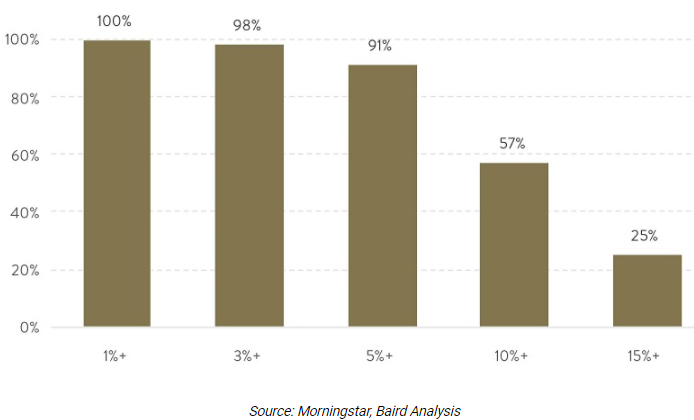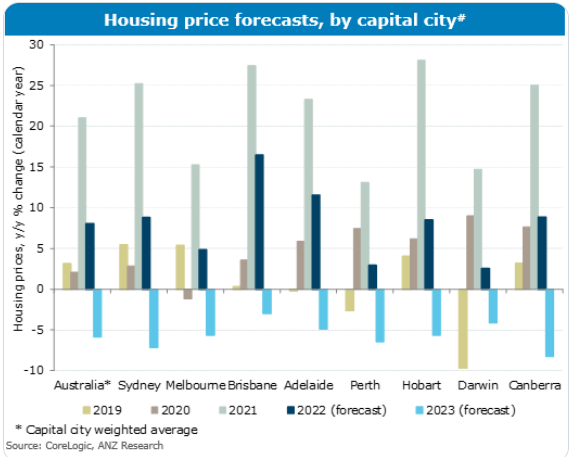The Weekend Edition includes a market update plus Morningstar adds links to two recent stock pick highlights from the week.
Weekend market update
From AAP Netdesk: A change in fortunes for fund manager Magellan proved a rare bright spot on an Australian share market weighed down by fears of conflict in Ukraine. Magellan shares closed higher by 18% after a better first-half profit and a discount options offer for investors. Magellan closed at $21.70. The ASX closed 1% lower on Friday and every share category was down after Russian-backed rebels and Kyiv government forces continued trading fire.
European and US leaders have threatened economic sanctions against Russia, which would have major implications for oil supply should troops invade Ukraine. Utilities were the worst-performing ASX category and dropped 4%. This included Origin Energy diving 8% to $5.65 a day after bringing forward the closure of Australia's largest coal-fired power station by three years to 2025.
Healthcare shares fared next worst and lost 3%. Market giant CSL shed 4% to $273.97, closing the week higher by 6% after its first-half earnings.
The market was higher for the week by 0.1%, making it three consecutive weeks of gains. Six of the top 10 performing stocks this week were gold ones.
Evolution, Northern Star and Silver Lake Resources were all at least 12% higher as the gold price fetched its highest price in eight months.
Latitude Group confirmed it will buy the consumer business of buy now, pay later group Humm for $335 million. In banking, Westpac was the only one of the majors to improve and did so by less than 0.5% to $23.53. The big miners were all lower.
From Shane Oliver, AMP Capital: Share markets have seen another volatile week being buffeted by fears of Russia invading Ukraine and fears of inflation and interest rate hikes. For the week US shares fell 1.6%, Eurozone shares fell 1.9% and Japanese shares fell 2.1%. Chinese shares rose 1.1%. US and global shares look like retesting their January lows and possibly breaking below them and this would likely drag Australian shares back down there too.
Long-term bond yields fell in the US and Europe as safe haven demand offset rising inflation and rate hike expectations but with yields up slightly in Japan and Australia. Oil prices briefly rose to their highest since 2014 on Ukraine tensions before falling back. Metal prices rose, but the iron ore price fell.
Pressure for monetary tightening continued over the last week. Both the UK and Canada saw higher than expected increases in inflation in January of 5.5% yoy and 5.1% yoy respectively, pointing to further rate hikes. The minutes from the last Fed meeting highlighted upside risks to inflation and that a faster pace of rate increases was likely compared to the post 2015 period but it was no more hawkish than previously flagged and there was little to point to a 0.5% initial hike.
What could drive a June rate hike from the RBA? Our base case remains that the first hike will come in August but the risk of an earlier move in June is high, and this has been reinforced by another strong jobs report for January. The RBA is clearly focussed on achieving full employment, seeing wages growth of 3% or more and the trimmed mean measure of inflation being sustained in the target range.
Via Bloomberg: US markets continued their falls on Friday, with the S&P500 down 0.7% to 4,349 and the tech NASDAQ again losing even more, down 1.2%. Traders are shunning risk amid Russian angst.
***
After all the media exposure on Magellan and Hamish Douglass in recent weeks, including my interview, Geraldine Doogue asked me to discuss fund managers on her Saturday Extra programme on ABC's Radio National. She did not want to talk specifically about Hamish, but I thought the subject was something like, "How do you pick a good fund manager?" In fact, in her first question, she asked me, "What type of person is attracted to stock picking at this level?", which is different.
I've been rethinking the question ever since. My initial response was to quote the statistic that about 80% of large equity managers underperform their benchmarks over a long time period such as 10 years, and even the 'winners' in the 20% have a one-year period where they underperform, and 85% do so over a three-year period. My first point was that a fund manager must be resilient and consistent and able to withstand and explain long periods of failing to deliver.
An investor joining the fund at the wrong time might experience many poor years and give up before the fund manager can recover. This was explained in more detail by Andrew Mitchell of Ophir almost a year ago, and more than half of these top fund managers underperform by a remarkable 10%+ over some 12-month period in the 10 years. Selecting a fund manager is a long-term decision.
Percentage of top-performing funds over 10 years that underperformed over any 12-month period and by how much

There's another common trait in fund managers who I rate highly. They recognise a theme or trend early and back it. My first observation of this was the legendary Greg Perry when we both worked at Colonial First State when his early move into infrastructure and especially toll roads paid off handsomely. Good fund managers read widely, listen to new ideas, they are naturally curious, follow the science and find companies that will win from these trends.
According to the publication Inc., writing on Warren Buffett:
“Buffett reportedly spends as much as six hours a day reading books. It may be a daunting prospect for most busy people, but if you're up to the task, the Oracle of Omaha advises that we 'read 500 pages every day'. He says that's how knowledge works - it builds up like compound interest.”
Picking successful, long-term active managers who are worth their fees is not easy, but instead of listening for the hot stock tips based on a short-term valuation, find the fund managers who look 10 years ahead and present a strong case why they are at the front of the curve. This is not an argument for active over passive, but rather, a core/satellite portfolio with index at the core and talented managers for extra kick and diversification.
At the Morningstar Investor Conference last week, two successful funds management businesses debated the relative merits of Listed Investment Companies. Geoff Wilson of WAM reminded us how much he loves LIC discounts, but it was good to hear Chris Meyer of Pinnacle put another view based on the Antipodes experience (and Ellerston and Monash have made the same arguments). Wilson and Meyer both identified the 'Holy Grail' of LICs, but they were not the same. Can they both be right?
In the current market facing the certainty of rising interest rates, it's tempting to sell rather than tough it out. For the first time in 40 years of writing memos to clients, Howard Marks addresses the sell decision. It's not only about timing the sale but when do you get back in for the recovery?
Geoff Warren continues this theme by asking about the role of cash. It's amazing how good cash looks when the market falls 10%, and it's plausible in 2022 that returns from other assets will be poor.
Now that our leading economists are moving their forecasts for the next cash rate increase to as early as June, only a few months away, the Reserve Bank's view that rate rises would not come until 2024 looks like poor judgement. Chris Bedingfield examines house prices from another perspective, the supply and demand.
ANZ Bank released its forecasts yesterday and they expect a soft landing for house prices despite higher rates. The forecast is for up 8% in 2022 and down a modest 6% in 2023.

Still on property, I admit I can be a pain when it comes to friends and family asking my advice on investments. A mate told me last week that he was looking to buy an apartment in a holiday resort. One of the attractions is the ability to stay in the apartment when it is not rented out for short-term holidays. He said there was no point leaving money in the bank earning nothing and shares are too risky. This sounds like a scenario being considered by many readers looking for income in new places.
I'm sure he thought I would smile pleasantly and he would drive off to buy his dream with a view. Instead, I sent him this article from 2015. I have not changed the numbers so please read it knowing it is seven years old, but the arguments remain valid. These resorts are a crap shoot.
Adding to the potential headwinds for property, here is what Gareth Aird of CBA Economics said this week:
"We shift our central scenario for the first hike in the cash rate target to June 2022 (from August 2022). Our forecast profile now has the cash rate at 1.0% by end-2022 (a 15bp increase in June, followed by two 25bp increases in Q3 22 and a further 25bp in Q4 22). We expect one further 25bp rate hike in Q1 23 that takes the cash rate to 1.25% - our estimate of the neutral cash rate."
Market volatility throws up opportunities, and Gemma Dale has looked at stocks which were at or near their 52-week lows at the time of writing. These stocks ran hard as the market recovered from COVID but then gave back a lot of their gains, and Gemma asks if they are now worth another look.
New research from the University of Adelaide, sponsored by the SMSF Association, sheds light on the appropriate size of SMSFs to be competitive with larger funds, and why diversification again proves its merit. Researchers believe the ATO data on SMSFs is increasingly unreliable for comparisons.
Two bonus articles from Morningstar for the weekend as selected by Editorial Manager Emma Rapaport.
In an extended interview, Peter Warnes discusses the bear market in US technology stocks, interest rates and growth and his approach to investing outside the US and Australia. And ASX utility dividends are fading into the rear-view mirror for income investors, writes Lewis Jackson.
This week's White Paper from Western Asset looks at global inflation and highlights differences in recent inflationary impulses, expectations for inflation trajectories over the coming months and the potential implications for bond yields.
Finally, here's a quick summary of the changes in superannuation rules passed into legislation on 10 February 2022, all effective from 1 July 2022.
* Removal of the monthly salary minimum of $450 before an employee qualifies for the superannuation guarantee.
* Increase in amount of voluntary contributions that can be released from super under the First Home Super Saver Scheme from $30,000 to $50,000.
* Eligibility age for downsizer contributions allowing a contribution to super from the proceeds of selling a home decreased from 65 to 60.
* Increase in the cut-off age for the bring-forward rule applying to non-concessional contributions from 67 to 75.
There are also changes to the work test and exempt current pension income (ECPI) which are too complex to summarise here but will be covered in the near future.
Graham Hand, Managing Editor
Latest updates
PDF version of Firstlinks Newsletter
ETF Quarterly Report from Vanguard
IAM Capital Markets' Weekly Market Insight
ASX Listed Bond and Hybrid rate sheet from NAB/nabtrade
Monthly market update on listed hybrids from ASX
Indicative Listed Investment Company (LIC) NTA Report from Bell Potter
Monthly Investment Products update from ASX
Plus updates and announcements on the Sponsor Noticeboard on our website